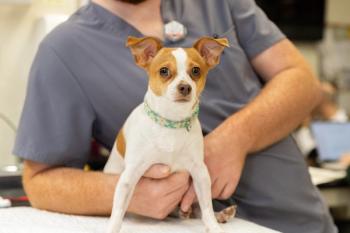
How Parvo is wreaking havoc on the pet community
Our panel weighs in on the heavy toll of this devastating disease
Episodes in this series

Sponsored by Elanco Animal Health
Adam Christman, DVM, MBA
Alright, so we got a lot of ground to cover my friends. So, you know, since the onset of canine parvo virus in the 1970s, we've made great strides with vaccination. But that being said, you know, we still seeing canine parvo virus cases. So I'll start with you, Dr. Lapin. So how common is parvo virus?
Michael Lappin, DVM, PhD, DACVIM
Yeah, I'm glad to start things out. It's amazing Adam, I was actually not there when it jumped from the cat to the dog that was alive, that it wasn't a veterinarian yet. I did notice that you did leave the dates of our graduation in the intro remarks, which is bad taste for sure. But being class of '81 from Oklahoma State University 1979, I did nine Doberman pinscher puppies when I was a third year student; eight of mine expired. And so it has been a love of mine for a period of time. And I would like to say that it's dropped a lot that the first five or six years at least until we got the canine vaccines rolling it was it was a bloodbath of dogs dying. We have over a period of time improved with the treatment, but it still happens. We were just talking a minute ago about how Fort Collins where the vet school's located is fairly affluent, and easily hits the kind of the herd immunity level. So 75, 80% vaccination, so we don't see as much right there around the vet school that you got just 32 miles to Greeley and dropping like flies. So there's still plenty of parvo virus in the United States.
Adam Christman, DVM, MBA
Wow. And Dr Zager, you live in Philadelphia, too. So is it common still in your neck of the woods?
Erik Zager, DVM, DACVECC
Unfortunately, it's way too common. In Philadelphia, we have lots of pockets of affluence and then lots of pockets of people who are economically disadvantaged, not having access to regular veterinary care, not being educated on how important vaccinations are. We have people who come in with patients that have parvo virus that didn't even know that there was a vaccine that could prevent it. And so it is a constant battle. And unfortunately, we see probably 100 plus cases a year just at our hospital alone, of parvo virus. And so even with great prevention options with vaccines, it is still a disease that is wreaking havoc on our on our pet community.
Adam Christman, DVM, MBA
Yeah. And Fathom I know there might be an over representation of what you're doing with your experience, but in your area, too. What is it like with parvo virus?
Fathom Woods
It's everywhere. Last year, we treated 1300 dogs in our ICU, and that's not even counting the at home Parvos that we will give them subcutaneous fluids and medication so that the owners can keep their pets. This year, we've already treated 700 cases in the ICU. And it's just, it's constant. Yeah, it's a huge problem. Sure.
Adam Christman, DVM, MBA
And out on the West Coast in Portland, Oregon area, what does it what does it like for you out there? So it's definitely something that we see within our community as well comparable to the other experiences that others have shared? And what is your first reaction? I'm curious to get all reactions on this when you hear "Oh my god, there's a parvo virus that, you know, a possible Parvo suspect coming down." What do you feel? Or what do you what do you, you and your team feel when you hear that? What was it like for the ER perspective?
Erik Zager, DVM, DACVECC
I mean, it's definitely not something you want to hear for a number of reasons. One is, these are young puppies that, you know, they were usually just, you know, purchased or adopted. They're just, you know, in their house. And these owners who have known these dogs for sometimes a matter of days, are now faced with horrible decisions about the health of their puppies, and financial issues, it is difficult for our staff, because with all the isolation protocols that have to go into place, it is a drain on resources on time, the amount of time it takes to do any treatment in isolation compared to another patient ICU, you multiply that by factors of 2, 3, 4, 5. And so it's drain on the hospital staff, on our morale, because, you know, while luckily, we are, you know, successful in the vast majority of these cases, every once in a while we do see patients to come to this disease. And when these are young, you know, otherwise, you know, healthy dogs that were just stricken with this preventable disease. It is really a big hit to the morale.
Adam Christman, DVM, MBA
I was like that at the teaching hospital.
Michael Lappin, DVM, PhD, DACVIM
Yeah at the teaching hospital, we have the same experience. Our critical care unit has a critical care isolation, but we try not to have infections of that magnitude within that area. So our small animal isolation is only 150 feet or so from the critical care but it just really drained staff because they've got to scrub and scrub out basically to take care of those paths. And it's just really draining.
Adam Christman, DVM, MBA
And fathom, you know, we deal with a lot of infectious diseases here in veterinary medicine, but this one tends to have a high mortality rate 91% if left untreated, so what what does that like for you and your team, when you hear something like that, especially with what you're doing for a living?
Fathom Woods
Well, we we have like a 91% save rate, which is kind of just the opposite. We strictly just treat Parvo. That's all we do. In the times where we do lose animals to the virus, it is heartbreaking. And I just tell the staff, you've got to focus on the ones you've saved. In the work we do is just so rewarding to see them come in so sick and they can barely lift their heads, and then we get them better. And sometimes, you know, they can go get adopted immediately. So those are the things we have to hold on to. But there are times where it is brutal.
Adam Christman, DVM, MBA
Yeah. What's your experience with a statistic like that from an ER perspective?
Erik Zager, DVM, DACVECC
Yeah, so especially as a referral hospital, we tend to see the sicker of the sick. And so, you know, I would say that, you know, those percentages, and as long as as owners are able to financially commit to what needs to be done, which can be really expensive at a specialty hospital. I'd say we see similar percentages of success, but it is, it doesn't matter how many you say but you know, when you see that that one puppy that that dies from this disease, it really is difficult to remember the successes and really, it hits the team really hard.
Newsletter
From exam room tips to practice management insights, get trusted veterinary news delivered straight to your inbox—subscribe to dvm360.


















